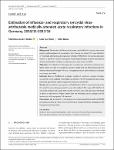Estimation of influenza‐ and respiratory syncytial virus‐attributable medically attended acute respiratory infections in Germany, 2010/11‐2017/18
an der Heiden, Matthias
Buchholz, Udo
Buda, Silke
Background
The burden of influenza in primary care is difficult to assess, since most patients with symptoms of a respiratory infection are not tested. The case definition of “medically attended acute respiratory infection” (MAARI) in the German physician sentinel is sensitive; however, it requires modelling techniques to derive estimates of disease attributable to influenza and respiratory syncytial virus (RSV).
Objectives
The objective of this paper was to review and extend our previously published model in order to estimate the burden of RSV and the differential burden of the two influenza B lineages (Victoria, Yamagata) as well as both influenza A subtypes on primary care visits.
Methods
Data on MAARI and virological results of respiratory samples (virological sentinel) were available from 2010/11 until 2017/18. We updated the previously published generalized additive regression model to include RSV.
Results
We found that the proportion of MAARI due to RSV is substantial only in the 0‐1‐ and 2‐4‐year‐old age groups (0‐1 years old: median 7.5%, range 4.0%‐14.8%; 2‐4 years old: median 6.5%, range 4.0%‐10.3%); in the 0‐1 years old age group, RSV leads in almost all seasons to a higher burden than any influenza type or subtype, but this is reversed in the age group 2‐4 years old.
Conclusions
We succeeded in rearranging our previously published model on MAARI to incorporate RSV as well as the two influenza B lineages (Victoria, Yamagata) in the time period 2010 to 2018.
Dateien zu dieser Publikation

